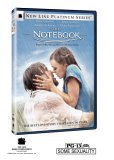Synopsis
In the present, in a nursing home, we meet two residents: James Garner and Gena Rowlands.She is afflicted with Alzheimer’s, and cannot remember her past. He reads to her from anotebook, telling the tale (which is their story) of two young people (Ryan Gosling and RacelMcAdams) who meet, fall in love, but are driven apart by class prejudice (she’s upper class, he’sworking class). He never gives up on her, and the story charts more heartbreaking reunions andtravails.
< ...>Good as old pros Garner and Rowlands are, they’re up against it with the plot’s sentimentalapproach to Alzheimer’s disease, which is not the pretty fogginess that sometimes clears ondisplay here. (Then again, attractive cancer deaths used to be the norm in tearjerkers, so perhapsI’m needlessly picky.) To Rowlands’ credit, she sometimes manages to convey something of thecruelty and terror of the disease in spite of the script. The plot is all too familiar, and isn’t inleague with such classic weepies as Now, Voyager. The cinematography is spectacular,but is too consciously so: the CGI water birds in the opening sunset sequence are simply toomuch to bear. And this nostalgic vision of the south is even worse.
Audio
The audio is solid, though the volume level is rather low. Turn it up enough, and the result isquite satisfying, with solid environmental effects (the carnival scenes, for instance, are nicelyenveloping). The dialogue is free of distortion as well. The soundtrack is subdued, but wellrendered.
Video
Two aspect ratios: fullscreen and 2.35:1 anamorphic (which means the fullscreen is amassive butchering of the actual image). The colours are gorgeous — I may have problems withthe aforementioned too-beautiful sunset opening, but artistic judgement aside, the presentationof the colours is astonishing. Contrasts and blacks are both excellent, and there is no grain, butthere is some visible edge enhancement.
Special Features
Commentary 1 is by director Nick Cassavetes (working a long way from the gritty emotionaldramas his father specialized in). His discussion covers all the making-of aspects one wouldwant, and is very articulate. If you’re more interested in the themes, there’s the second track byNicholas Sparks, on whose book the film is based. There are 12 alternate or deleted scenes. Thefeaturettes are all fairly standard promotional efforts, but at least have a fairly precise focus: “Allin the Family” spotlights Cassavetes, “A Simple Story, Well Told” is about Sparks and his book,“Southern Exposure” looks at the location shooting, and “Casting Rachel and Ryan” is prettyself-explanatory. The latter is paired with McAdams’ screen test. Also here are the theatricaltrailer and some DVD-ROM features. The menu’s main screen is animated and scored, as arethe transitions. The other screens are scored.
Closing Thoughts
A handsome-looking tearjerker, to be sure, but also a bit suspect and very hackneyed in itsplot.
Special Features List
- Audio Commentaries
- “All in the Family: Nick Cassavetes” Featurette
- “Nicholas Sparks: A Simple Story, Well Told” Featurette
- “Southern Exposure: Locating The Notebook” Featurette
- “Casting Rachel and Ryan” Featurette
- Rachel McAdams Screen Test
- Theatrical Trailer
- DVD-ROM Features






